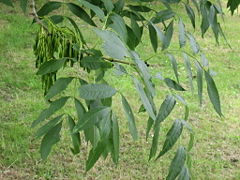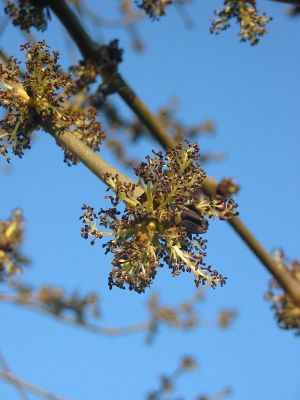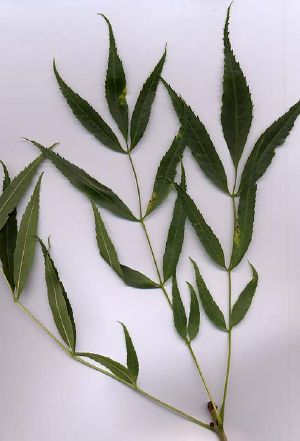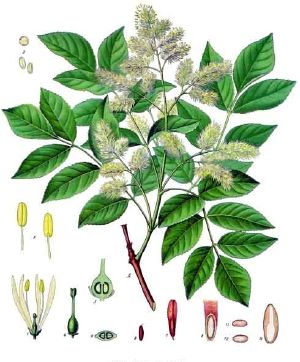Difference between revisions of "Ash (tree)" - New World Encyclopedia
({{Contracted}}) |
Rick Swarts (talk | contribs) (added article from Wikipedia and credit/category tags) |
||
| Line 1: | Line 1: | ||
{{Claimed}}{{Contracted}} | {{Claimed}}{{Contracted}} | ||
| + | |||
| + | {{Taxobox | ||
| + | | color = lightgreen | ||
| + | | image = Fraxinus excelsior.jpg | ||
| + | | image_width = 240px | ||
| + | | image_caption = European Ash (''Fraxinus excelsior'') | ||
| + | | regnum = [[Plant]]ae | ||
| + | | divisio = [[Flowering plant|Magnoliophyta]] | ||
| + | | classis = [[Magnoliopsida]] | ||
| + | | ordo = [[Lamiales]] | ||
| + | | familia = [[Oleaceae]] | ||
| + | | genus = '''''Fraxinus''''' | ||
| + | | genus_authority = [[Joseph Pitton de Tournefort|Tourn.]] ex [[Carolus Linnaeus|L.]] | ||
| + | | subdivision_ranks = Species | ||
| + | | subdivision = See text | ||
| + | }} | ||
| + | [[Image:Ash flower.JPG|thumb|European Ash in flower]] | ||
| + | [[Image:NarrowleafAsh.jpg|thumb|Narrow-leafed Ash (''Fraxinus angustifolia'') shoot with leaves]] | ||
| + | [[Image:EunnnnnmmkjrAshSeeds.jpg|thumb|Closeup of European Ash seeds]] | ||
| + | [[Image:Koeh-062.jpg|thumb|19th century illustration of Manna Ash (''Fraxinus ornus'')]] | ||
| + | |||
| + | An '''ash''' can be any of four different tree [[genus|genera]] from four very distinct [[family (biology)|families]] (see end of page for disambiguation), but originally and most commonly refers to trees of the genus ''Fraxinus'' (from [[Latin]] "ash tree") in the [[olive]] family [[Oleaceae]]. The ashes are usually medium to large [[tree]]s, mostly [[deciduous]] though a few subtropical species are [[evergreen]]. The [[leaf|leaves]] are opposite (rarely in whorls of three), and mostly pinnately-compound, simple in a few [[species]]. The [[seed]]s, popularly known as ''keys'', are a type of [[fruit]] known as a '''[[samara (fruit)|samara]]'''. The tree's common English name goes back to the Old English ''æsc'', a word also routinely used in Old English documents to refer to spears made of ash wood. | ||
| + | |||
| + | ==Selected species== | ||
| + | ;Ashes of eastern [[North America]] | ||
| + | * ''[[Fraxinus americana]]'' White Ash (also called cane ash, Biltmore ash or Biltmore white ash) | ||
| + | * ''[[Fraxinus caroliniana]]'' Water Ash | ||
| + | * ''[[Fraxinus nigra]]'' Black Ash (also called swamp ash, basket ash, brown ash, hoop ash, or water ash) | ||
| + | * ''[[Fraxinus pennsylvanica]]'' Green Ash (also called red ash, swamp ash or water ash) | ||
| + | * ''[[Fraxinus profunda]]'' (syn. ''F. tomentosa'') Pumpkin Ash (also called red ash) | ||
| + | * ''[[Fraxinus quadrangulata]]'' Blue Ash | ||
| + | |||
| + | ;Ashes of western and southwestern [[North America]] | ||
| + | * ''[[Fraxinus anomala]]'' Single-leaf Ash | ||
| + | * ''[[Fraxinus cuspidata]]'' Fragrant Ash | ||
| + | * ''[[Fraxinus dipetala]]'' California Ash or Two-petal Ash | ||
| + | * ''[[Fraxinus dubia]]'' | ||
| + | * ''[[Fraxinus gooddingii]]'' Goodding's Ash | ||
| + | * ''[[Fraxinus greggii]]'' Gregg's Ash | ||
| + | * ''[[Fraxinus latifolia]]'' Oregon Ash | ||
| + | * ''[[Fraxinus lowellii]]'' Lowell Ash | ||
| + | * ''[[Fraxinus papillosa]]'' Chihuahua Ash | ||
| + | * ''[[Fraxinus purpusii]]'' | ||
| + | * ''[[Fraxinus rufescens]]'' | ||
| + | * ''[[Fraxinus texensis]]'' Mountain Ash or Texas Ash | ||
| + | * ''[[Fraxinus uhdei]]'' Shamel Ash or Tropical Ash | ||
| + | * ''[[Fraxinus velutina]]'' Velvet Ash | ||
| + | |||
| + | ;Ashes of the Western [[Palearctic]] ([[Europe]], north [[Africa]] and southwest [[Asia]]) | ||
| + | * ''[[Fraxinus angustifolia]]'' Narrow-leafed Ash | ||
| + | ** ''[[Fraxinus angustifolia]]'' var. ''oxycarpa'' (syn. ''F. oxycarpa'') Caucasian Ash | ||
| + | * ''[[Fraxinus excelsior]]'' European Ash | ||
| + | * ''[[Fraxinus holotricha]]'' | ||
| + | * ''[[Fraxinus ornus]]'' Manna Ash or Flowering Ash | ||
| + | * ''[[Fraxinus pallisiae]]'' Pallis' Ash | ||
| + | |||
| + | ;Ashes of the Eastern [[Palearctic]] (central & eastern [[Asia]]) | ||
| + | * ''[[Fraxinus apertisquamifera]]'' | ||
| + | * ''[[Fraxinus baroniana]]'' | ||
| + | * ''[[Fraxinus bungeana]]'' Bunge's Ash | ||
| + | * ''[[Fraxinus chinensis]]'' Chinese Ash or Korean Ash | ||
| + | * ''[[Fraxinus chiisanensis]]'' | ||
| + | * ''[[Fraxinus floribunda]]'' Himalayan Manna Ash | ||
| + | * ''[[Fraxinus griffithii]]'' Griffith's Ash | ||
| + | * ''[[Fraxinus hubeiensis]]'' | ||
| + | * ''[[Fraxinus japonica]]'' Japanese Ash | ||
| + | * ''[[Fraxinus lanuginosa]]'' | ||
| + | * ''[[Fraxinus longicuspis]]'' | ||
| + | * ''[[Fraxinus malacophylla]]'' | ||
| + | * ''[[Fraxinus mandshurica]]'' Manchurian Ash | ||
| + | * ''[[Fraxinus mariesii]]'' Chinese Flowering Ash | ||
| + | * ''[[Fraxinus micrantha]] '' | ||
| + | * ''[[Fraxinus paxiana]] '' | ||
| + | * ''[[Fraxinus platypoda]]'' | ||
| + | * ''[[Fraxinus raibocarpa]]'' | ||
| + | * ''[[Fraxinus sieboldiana]]'' Japanese Flowering Ash | ||
| + | * ''[[Fraxinus spaethiana]]'' Späth's Ash | ||
| + | * ''[[Fraxinus trifoliata]]'' | ||
| + | * ''[[Fraxinus xanthoxyloides]]'' Afghan Ash | ||
| + | |||
| + | ==Threats== | ||
| + | The [[emerald ash borer]] ''Agrilus planipennis'', a wood-boring [[beetle]] accidentally introduced to North America from eastern Asia with ash wood products in about [[1998]], has killed millions of trees in southeast [[Michigan]], adjacent [[Ontario]], and some isolated smaller areas on eastern North America. It threatens some 7 billion ash trees in North America. Ash is also used as a food plant by the [[larva]]e of some [[Lepidoptera]] species - see [[list of Lepidoptera which feed on Ashes]]. | ||
| + | |||
| + | ==Uses== | ||
| + | The [[wood]] is hard (a [[hardwood]]), tough and very strong but elastic, extensively used for making [[bow (weapon) |bows]], [[tool]] handles, quality wooden [[baseball bat]]s, [[hurley (stick)|hurley sticks]] and other uses demanding high strength and resilience. It is also used as material for the bodies of guitars, known for its bright, cutting tone and sustaining quality. Ash veneers are extensively used in office furniture. It also makes excellent [[wood fuel#Firewood|firewood]]. The two most economically important species for wood production are White Ash in eastern North America, and European Ash in Europe. The Green Ash is widely planted as a street tree in the United States. The inner bark of the Blue Ash has been used as a source for a blue [[dye]]. | ||
| + | The cortex (bark) of ''Fraxinus rhynchophylla'' HANCE (Chinese: Ku li bai la shu), ''Fraxinus chinensis'' ROXB. (Chinese: Bai la shu), ''Fraxinus szaboana'' English (Chinese: Jian ye bai la shu) and ''Fraxinus stylosa'' English (Chinese: su zhu bai la shu)are used in Traditional Chinese Medicine (TCM) for diarrhea, dysenteric disorder, and vaginal discharge. It is also good for the eyes where there is symptoms of redness, swelling, and pain. The dosage is 6-12 grams. | ||
| + | |||
| + | ==Cultural aspects== | ||
| + | In [[Norse mythology]], the World Tree [[Yggdrasil]] is commonly held to be an ash tree, and the first man, [[Ask and Embla|Ask]], was formed from an ash tree (the first woman was made from [[elm]]). Elsewhere in Europe, [[snake]]s were said to be repelled by ash leaves or a circle drawn by an ash branch. Irish folklore claims that shadows from an ash tree damage crops. In [[Cheshire]], it is said that ash could be used to cure warts or rickets. See also [[Æ|the letter ash]]. | ||
| + | |||
| + | In [[Greek mythology]], the [[Meliai]] were nymphs of the ash, perhaps specifically of the Manna Ash (''Fraxinus ornus''), as [[dryad]]s were nymphs of the oak. Many echoes of archaic Hellene rites and myth involve ash trees. | ||
| + | |||
| + | The ash is thought to exude a sugary substance that was fermented to create the Norse "Mead of Inspiration."[http://www.musaios.com/ash.htm] | ||
| + | |||
| + | ==Other name uses (Green Tree)== | ||
| + | In [[North America]], the name "Mountain ash" is applied to species of the genus ''[[Sorbus]]'', more commonly known in the UK as [[Rowan]]s and [[Whitebeam]]s, and the name "[[Prickly ash]]" is applied to ''[[Zanthoxylum]] americanum'' and other Zanthoxylums, all in the family [[Rutaceae]], the rue and citrus family. In [[Australia]], many common [[eucalyptus]] species are called ''ash'' because they too produce hard, fine-grained timber. The best known of these is the [[Eucalyptus regnans|Mountain Ash]], the tallest [[angiosperm|broadleaf]] tree in the world. | ||
| + | |||
| + | [[Category:Life sciences]] | ||
| + | [[Category:Plants]] | ||
| + | {{credit|Ash_tree|160584022}} | ||
Revision as of 01:07, 30 September 2007
| {{{name}}} | ||||||||||||
|---|---|---|---|---|---|---|---|---|---|---|---|---|
 European Ash (Fraxinus excelsior)
| ||||||||||||
| Scientific classification | ||||||||||||
| ||||||||||||
|
See text |
An ash can be any of four different tree genera from four very distinct families (see end of page for disambiguation), but originally and most commonly refers to trees of the genus Fraxinus (from Latin "ash tree") in the olive family Oleaceae. The ashes are usually medium to large trees, mostly deciduous though a few subtropical species are evergreen. The leaves are opposite (rarely in whorls of three), and mostly pinnately-compound, simple in a few species. The seeds, popularly known as keys, are a type of fruit known as a samara. The tree's common English name goes back to the Old English æsc, a word also routinely used in Old English documents to refer to spears made of ash wood.
Selected species
- Ashes of eastern North America
- Fraxinus americana White Ash (also called cane ash, Biltmore ash or Biltmore white ash)
- Fraxinus caroliniana Water Ash
- Fraxinus nigra Black Ash (also called swamp ash, basket ash, brown ash, hoop ash, or water ash)
- Fraxinus pennsylvanica Green Ash (also called red ash, swamp ash or water ash)
- Fraxinus profunda (syn. F. tomentosa) Pumpkin Ash (also called red ash)
- Fraxinus quadrangulata Blue Ash
- Ashes of western and southwestern North America
- Fraxinus anomala Single-leaf Ash
- Fraxinus cuspidata Fragrant Ash
- Fraxinus dipetala California Ash or Two-petal Ash
- Fraxinus dubia
- Fraxinus gooddingii Goodding's Ash
- Fraxinus greggii Gregg's Ash
- Fraxinus latifolia Oregon Ash
- Fraxinus lowellii Lowell Ash
- Fraxinus papillosa Chihuahua Ash
- Fraxinus purpusii
- Fraxinus rufescens
- Fraxinus texensis Mountain Ash or Texas Ash
- Fraxinus uhdei Shamel Ash or Tropical Ash
- Fraxinus velutina Velvet Ash
- Ashes of the Western Palearctic (Europe, north Africa and southwest Asia)
- Fraxinus angustifolia Narrow-leafed Ash
- Fraxinus angustifolia var. oxycarpa (syn. F. oxycarpa) Caucasian Ash
- Fraxinus excelsior European Ash
- Fraxinus holotricha
- Fraxinus ornus Manna Ash or Flowering Ash
- Fraxinus pallisiae Pallis' Ash
- Ashes of the Eastern Palearctic (central & eastern Asia)
- Fraxinus apertisquamifera
- Fraxinus baroniana
- Fraxinus bungeana Bunge's Ash
- Fraxinus chinensis Chinese Ash or Korean Ash
- Fraxinus chiisanensis
- Fraxinus floribunda Himalayan Manna Ash
- Fraxinus griffithii Griffith's Ash
- Fraxinus hubeiensis
- Fraxinus japonica Japanese Ash
- Fraxinus lanuginosa
- Fraxinus longicuspis
- Fraxinus malacophylla
- Fraxinus mandshurica Manchurian Ash
- Fraxinus mariesii Chinese Flowering Ash
- Fraxinus micrantha
- Fraxinus paxiana
- Fraxinus platypoda
- Fraxinus raibocarpa
- Fraxinus sieboldiana Japanese Flowering Ash
- Fraxinus spaethiana Späth's Ash
- Fraxinus trifoliata
- Fraxinus xanthoxyloides Afghan Ash
Threats
The emerald ash borer Agrilus planipennis, a wood-boring beetle accidentally introduced to North America from eastern Asia with ash wood products in about 1998, has killed millions of trees in southeast Michigan, adjacent Ontario, and some isolated smaller areas on eastern North America. It threatens some 7 billion ash trees in North America. Ash is also used as a food plant by the larvae of some Lepidoptera species - see list of Lepidoptera which feed on Ashes.
Uses
The wood is hard (a hardwood), tough and very strong but elastic, extensively used for making bows, tool handles, quality wooden baseball bats, hurley sticks and other uses demanding high strength and resilience. It is also used as material for the bodies of guitars, known for its bright, cutting tone and sustaining quality. Ash veneers are extensively used in office furniture. It also makes excellent firewood. The two most economically important species for wood production are White Ash in eastern North America, and European Ash in Europe. The Green Ash is widely planted as a street tree in the United States. The inner bark of the Blue Ash has been used as a source for a blue dye. The cortex (bark) of Fraxinus rhynchophylla HANCE (Chinese: Ku li bai la shu), Fraxinus chinensis ROXB. (Chinese: Bai la shu), Fraxinus szaboana English (Chinese: Jian ye bai la shu) and Fraxinus stylosa English (Chinese: su zhu bai la shu)are used in Traditional Chinese Medicine (TCM) for diarrhea, dysenteric disorder, and vaginal discharge. It is also good for the eyes where there is symptoms of redness, swelling, and pain. The dosage is 6-12 grams.
Cultural aspects
In Norse mythology, the World Tree Yggdrasil is commonly held to be an ash tree, and the first man, Ask, was formed from an ash tree (the first woman was made from elm). Elsewhere in Europe, snakes were said to be repelled by ash leaves or a circle drawn by an ash branch. Irish folklore claims that shadows from an ash tree damage crops. In Cheshire, it is said that ash could be used to cure warts or rickets. See also the letter ash.
In Greek mythology, the Meliai were nymphs of the ash, perhaps specifically of the Manna Ash (Fraxinus ornus), as dryads were nymphs of the oak. Many echoes of archaic Hellene rites and myth involve ash trees.
The ash is thought to exude a sugary substance that was fermented to create the Norse "Mead of Inspiration."[1]
Other name uses (Green Tree)
In North America, the name "Mountain ash" is applied to species of the genus Sorbus, more commonly known in the UK as Rowans and Whitebeams, and the name "Prickly ash" is applied to Zanthoxylum americanum and other Zanthoxylums, all in the family Rutaceae, the rue and citrus family. In Australia, many common eucalyptus species are called ash because they too produce hard, fine-grained timber. The best known of these is the Mountain Ash, the tallest broadleaf tree in the world.
Credits
New World Encyclopedia writers and editors rewrote and completed the Wikipedia article in accordance with New World Encyclopedia standards. This article abides by terms of the Creative Commons CC-by-sa 3.0 License (CC-by-sa), which may be used and disseminated with proper attribution. Credit is due under the terms of this license that can reference both the New World Encyclopedia contributors and the selfless volunteer contributors of the Wikimedia Foundation. To cite this article click here for a list of acceptable citing formats.The history of earlier contributions by wikipedians is accessible to researchers here:
The history of this article since it was imported to New World Encyclopedia:
Note: Some restrictions may apply to use of individual images which are separately licensed.


